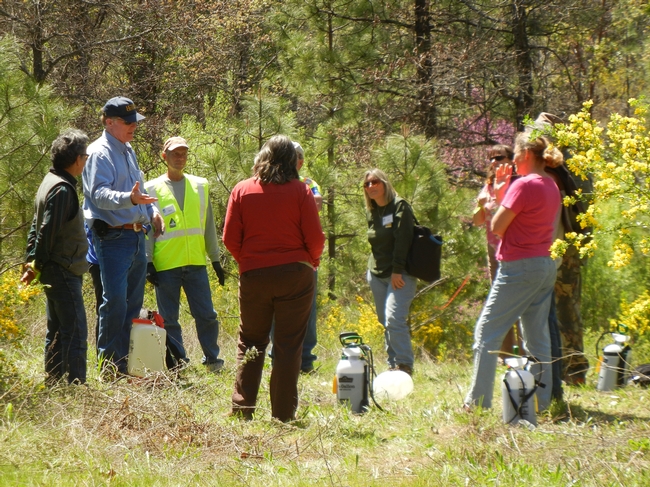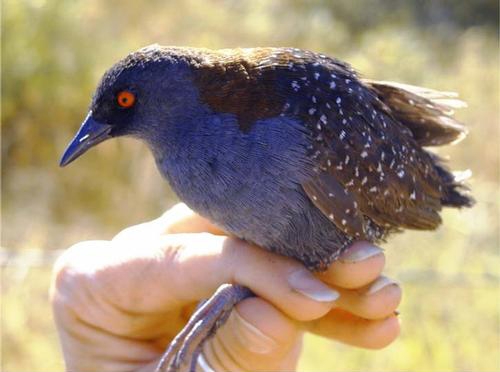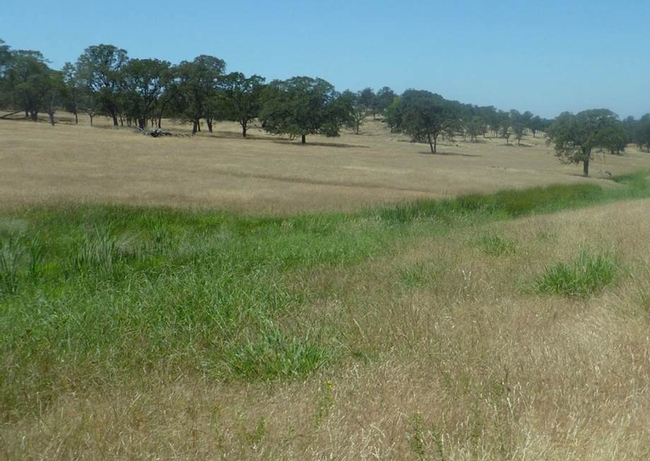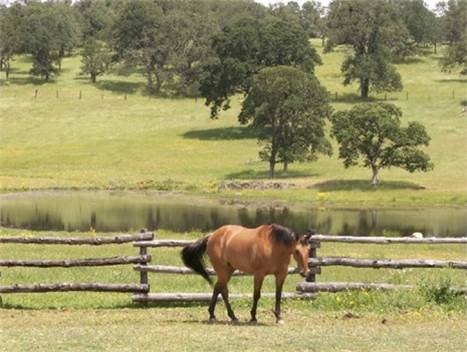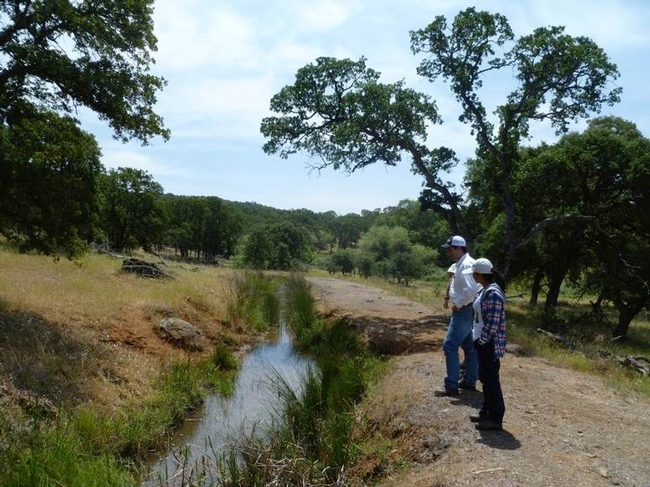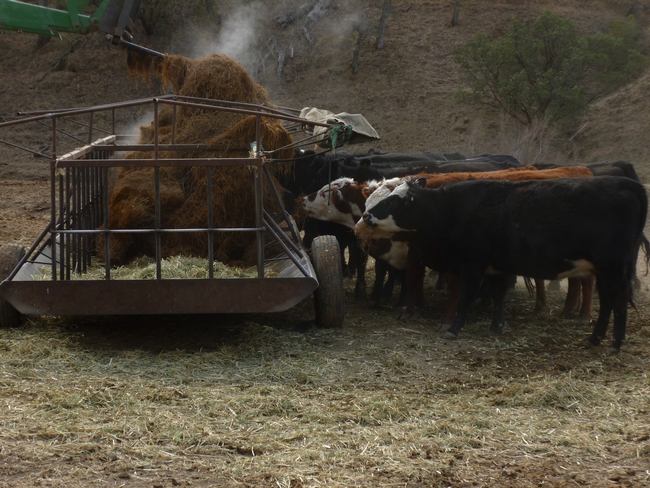Posts Tagged: Glenn Nader
UC advisor to Northern California ranchers rides off into the sunset
Glenn Nader, UC Agriculture and Natural Resources Cooperative Extension livestock and natural resources advisor in Sutter and Yuba counties, retired on March 14 after 32 years supporting the iconic California cattle ranching industry.
“I feel blessed to have been able to be in an organization that allows you to come to work each day and use the power of the University of California system to solve local problems and help improve people's lives,” Nader said.
After earning a bachelor's degree in animal science at California State University, Chico, and a master's degree in animal nutrition from UC Davis, Nader joined UC ANR in 1982 as a livestock and natural resources advisor in Lassen County. Over the years, advances in information technology dramatically changed the way he communicated with ranchers.
In the early 1980s, Nader mimeographed lengthy newsletters and mailed them to clientele. In recent times, he emailed a paragraph with hyperlinks to more information. While in Lassen County, Nader also maintained a morning agriculture radio program as a method of extending information.
“I am impressed that UC ANR allows advisors to able to lead collaborative groups to solve problems in the field,” Nader said, a practice that he used numerous times over his career.
Examples include his work in the Pine Creek Coordinated Management Plan and the Yuba and Butte counties coordinated pre-fire management plan. A recent article in California Agriculture journal, UC Cooperative Extension works with fire councils to reduce wildfires, highlights the pre-fire plan's role in stopping two potentially catastrophic fires. Although not a fire scientist himself, Nader aggregated the basic concepts from UC Cooperative Extension during a sabbatical leave to be better able to address problems of the local communities he served.
The groups that he worked with were honored with the Smoky Bear Award and the Cal Fire Service Award. The Pine Creek CRMP group's work was cited as a reason to not list the Eagle Lake trout as endangered. Nader also used his animal science background to work with other advisors to publish information on how grazing could be used as a tool reduce fuels.
In 1996, Nader transferred to Sutter and Yuba counties. He said looks back on the rice straw research he conducted with animal science specialist Peter Robinson there with a sense of fulfillment. Their work over 14 years showed that preventing rice straw from drying greatly increases the nutritional value to animals. Their work was one of the UC Cooperative Extension programs recognized with the Circle of Life award from the California Rice Commission.
Nader was named the Cattleman of the Year from both the Lassen and Butte county Cattlemen's associations. He was recognized by the California Cattlemen's Association for his education and research work. The Butte and Yuba Fire Safe Councils honored Nader for his assistance in forming and for actively participating in their councils.
“I saw the councils as the perfect platform to extend research information to local residents on what they could do to reduce their risks to wildfire,” Nader said.
During a presentation to UC President Dynes on pre-fire planning, the resulting discussion revealed a need to teach the thermal transfer process for people to better understand how fire science related to fire safety recommendations.
“This is an example of how the interaction with UC faculty that can perfect the impact of Cooperative Extension,” he said.
Nader said he especially enjoyed the people he worked with during his career.
“I appreciate all the clientele and ANR staff that allowed me to greatly enjoy the blessing of being a farm advisor for 32 years,” Nader said.
During retirement he plans to spend more time with his wife Marie and son Alan on their Modoc County ranch.
California black rail likes leaks
While Californians are tightening their pipes to conserve water during this fourth year of drought, the California black rail might say, “Let it leak,” if it could speak.
The rare bird species makes its home in marshes created in large part by leaky pipes, stock ponds, irrigation tailwater and unlined canals. Even the springs that support some habitat may rely on water flowing from leaky canals. In 1994, UC Agriculture and Natural Resources scientists found the small, red-eyed bird with the black breast and speckled black feathers at UC ANR's Sierra Foothill Research and Extension Center. Since its discovery, a group of scientists have been exploring the effects of water management and climate change on the bird in Sutter, Butte and Yuba counties.
California black rails, which can be heard more often than seen, largely depend on humans and irrigated agriculture to provide the shallow flowing water they use for habitat.
Because most of the rangeland in the area is privately held, and includes irrigated pasture for livestock, Lynn Huntsinger, professor in the Department of Environmental Science, Policy and Management at UC Berkeley, wondered if property owners would be willing to maintain wetlands to support wildlife.
With the help of UC ANR Cooperative Extension advisors Glenn Nader and Roger Ingram, Huntsinger conducted a survey of 1,000 landowners in the three counties.
Property owners responding to the survey said the primary reason for maintaining ponds and wetlands is to reduce wildfire risk, but they also like the birds and wildlife that are attracted by wet areas. However, Huntsinger worries that the “accidental wetlands” may dry up as the drought increases the pressure on people to conserve water by fixing leaks and replacing canals built during the 19th century Gold Rush with pipes.
Most of the farmers and ranchers buy water from a water district so Huntsinger sees working with water districts as a key to the sustainability of wetlands for wildlife.
“Water is going to be more expensive and harder to access given the trends in weather and population demand,” she said. To predict how long landowners will continue to maintain wetlands if water prices rise, Huntsinger is working with Jose Oviedo, an environmental economist in Spain.
More and more, she says, it seems that we are facing tradeoffs between “goods”— saving water is good and preserving wildlife habitat is good. “We need flexibility and adaptation rather than all or nothing choices. After all, we are creating the future landscape of California,” Huntsinger said.
Huntsinger's study is just one facet of a California black rail study that involves scientists with different kinds of expertise.
Steve Beissinger, professor in the Department of Environmental Science, Policy and Management at UC Berkeley, has been studying black rail behavior for years and continues to monitor how many sites in the Sierra foothills the small birds use as habitat.
Norman Miller, a Lawrence Berkeley Laboratory hydrologist, is developing models to understand the water dynamics and sustainability of the wetlands habitat.
Marm Kilpatrick, assistant professor in the Department of Ecology and Evolutionary Biology at UC Santa Cruz, studies how concern about mosquito-borne West Nile virus may affect landowners' decisions to maintain wetlands.
“It is a novel ecosystem, offering habitat engineered by people and their livestock that happens to offer the black rail what it needs,” Huntsinger said. “We just don't know enough about conservation in this kind of situation. Managing traditional landscapes is common in Europe, but rare in the United States.”
For more information about the California black rail, see the California Agriculture article “California black rails depend on irrigation-fed wetlands in the Sierra Nevada foothills.”
Below, UC Berkeley graduate student Nathan Van Schmidt describes research at UC Sierra Foothill Research and Extension Center on how the rails cope with drought, seasonal hydrology regimes, and the rescue effect.
An initiative to maintain and enhance sustainable natural ecosystems is part of UC Agriculture and Natural Resources Strategic Vision 2025.
Ranchers learn how to turn straw into 'gold'
About 50 ranchers gathered this week in Willows to learn how they can convert straw left over from the rice harvest into a palatable and nutritious feed for cattle, reported Tim Hearden in Capital Press.
By baling rice straw before it dries and tarping it to keep the straw moist until it is fed to cattle, the feed, called "strawlage," is comparable to low-quality alfalfa, UC Cooperative Extension scientists say.
“We haven't figured everything out, but with the drought conditions as serious as they are, we feel the time is right to share our research with growers,” said Glenn Nader, the UCCE advisor who organized the field day.
Because of the drought, "There's going to be a significant problem with feed coming into this winter and rice strawlage may be an answer," said Peter Robinson, a UCCE specialist in the Department of Animal Science at Davis.
The feed can turn black and become a little slimy, but the cows don't seem to mind.
“The cattle do eat this really well,” rancher Herb Holzaphel said during the workshop. “It didn't feed as good as silage, but it fed better than normal straw.”
For more information, see the UC Rice Project website.
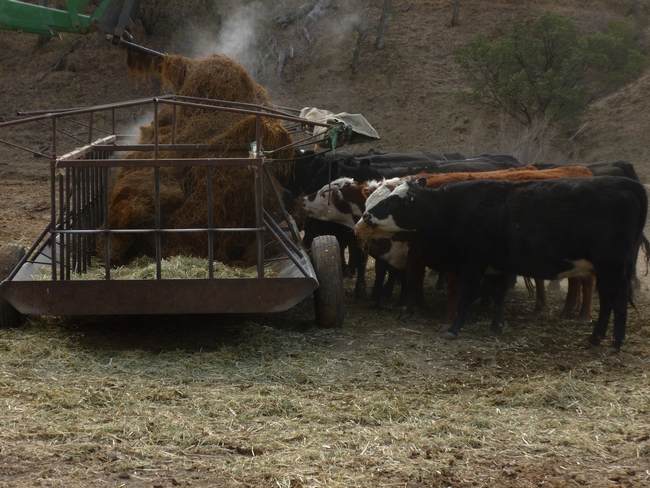
Cows attacking rice strawlage as tractor drops into feeder.
Livestock producers and rice farmers can work together to solve each other’s problems
UC Cooperative Extension advisor Glenn Nader believes two problems could add up to one win-win solution.
The California drought has ranchers desperate for inexpensive livestock feed. Air quality protection regulations that limit rice straw burning leave the rice industry with an abundance of typically low-quality straw to unload. Though it has rarely been done, Nader believes special treatment of rice straw will make it a nutritious cattle food. Two problems solved.
Nader will introduce producers to this new way to get through the drought at a meeting from 9 a.m. to 12 noon July 29 at the Veterans Memorial Hall, 525 W. Sycamore St., Willows, Calif.
When rice straw dries, its value as a forage declines dramatically. For 15 years, UC researchers have been trying to figure out why, but the reason for the significant change is not understood at this time.
“At one time, we thought the problem was silica in the straw,” Nader said. “We grew silica-free rice. That didn't work. We thought it was the crystallinity of molecules in the straw. We parsed apart the plant, and we still don't know.”
Ultimately, it was a rancher who suggested the scientists to put aside their desire to know why quality declines when rice straw dries and look for practical ways to get around it. Nader postponed his retirement to comply.
Normally, rice growers bale the straw two to four days after harvest. Nader and his colleagues instead baled the straw immediately after it exited the grain harvester. They stacked the green straw bales and covered them with a tarp to retain moisture and prevent spontaneous combustion. The result is a product they named “strawlage.” One worry is mold. The researchers found that treating the straw with propionic acid prevents fungus growth.
“We haven't figured everything out, but with the drought conditions as serious as they are, we feel the time is right to share our research with growers,” Nader said. “We invite producers to come to the meeting to see if this will work for their operations. Several producers who have already fed strawlage to their cattle will speak at the meeting about their experiences.”
Nader believes the UC research into using rice straw for livestock feed will be helpful throughout the world.
Asian farmers produce rice straw in great abundance and their livestock would benefit significantly if the farmers worked to maintain the plant's moisture until it reaches cattle feeding troughs.
The July 29 meeting will cover:
- Nutritional advantages of strawlage over rice straw
- The challenges of baling the straw at 50 to 60 percent moisture
- Additives to prevent mold
- How to stake and tarp strawlage
- The costs associated with the practice
- How cows that ate strawlage last year fared
“Our goal is to give producers information that will allow them to make rice strawlage during this fall's harvest,” Nader said. “Both cattle and rice producers are encouraged to attend.”
It's raining in California, but drought concerns haven't been quenched
A storm is dropping some much-needed moisture in California today, but the drought drags on. Using UC sources, the media has been reporting on the effect of a prolonged rainless period this winter and well-below-average rainfall the last three years.
A story in the Los Angeles Times this week opened with the concerns of cattle ranchers. Without winter rain rangeland grass doesn't grow. Ranchers must decide whether to buy expensive feed or cull their herds to weather the drought.
"Their struggle is a bellwether for California's $45 billion agriculture sector," wrote reporter David Pierson. The repercussions will be felt beyond the state's borders. "The Golden State produces nearly half of all U.S.-grown fruits, nuts and vegetables and is the nation's leading dairy and wine producer."
Pierson quoted Doug Parker, director of the UC California Institute for Water Resources, in his article.
"The agriculture industry is definitely hit the hardest by drought," Parker said. "In California, agriculture uses 80 percent of water in the state. It's a major input for their business and hits their finances and employment directly."
The San Luis Obispo Tribune reported on drought hardships for SLO County fruit and vegetable farmers. Growers are facing increasing irrigation costs and taking steps to reduce salt buildup in the soil.
"The drought forces growers to prioritize crop cycles,” said Mary Bianchi, UC Cooperative Extension adviser. “What do you plant, and what do you leave fallow?”
In Stanislaus County, ranchers are expressing concerns about a trend among farmers toward planting almonds, reported the The Modesto Bee. Ranchers are worried the spread of almonds, walnuts an other high-value crops could strain their limited groundwater, drive up land prices and intrude on their way of life.
“It's not hard to understand why (farmers are planting more almonds),” said Roger Duncan, UCCE advisor. “It's very profitable.”
It was Duncan who provided the rough figures on almond profitability during the first day of the ninth annual summit of the California rangeland Conservation Coalition recently, wrote Bee reporter John Holland. Duncan said the net is even better for walnuts, which are not as extensive but still have had major growth in acreage. He also said the nut boom could be limited by a shortage of water and land.
The Drovers Cattle Network reported that cattle ranchers are seeking strategies for surviving the drought.
According to the article, rancher Billy McDonald's wife, Aileen, said she learned from UC Cooperative Extension farm advisor Glenn Nader that "you need to set a date, like if it doesn't rain by a certain date, to start culling. That's really important."
Also as part of the story, Roger Ingram, UCCE advisor in Placer and Nevada counties, advised ranchers to develop a drought plan.
Ingram warned against overgrazing and emphasized the importance of leaving enough residual dry matter in the ground to enhance seed germination and minimize soil erosion. With more bare ground, water would run off instead of soaking in, he said, and there would be less organic matter to feed soil microbes, resulting in fields being overrun by undesirable plants such as medusahead and yellow starthistle.
"Your grazing strategy should be take half, leave half," he said.
For those who are on irrigated pasture with limited water supply, UCCE advisor Larry Forero said fields are the driest in the summer but can get by with less water in the fall, so irrigate as close to evapotranspiration as possible and then stop irrigating. He also advised leaving four to five inches of stubble to facilitate pasture growth in the fall, should it rain or irrigation water become available.

